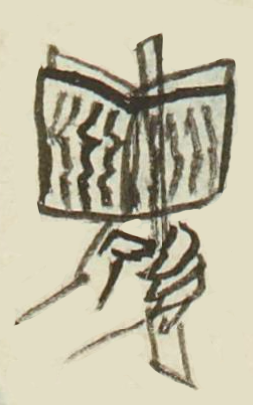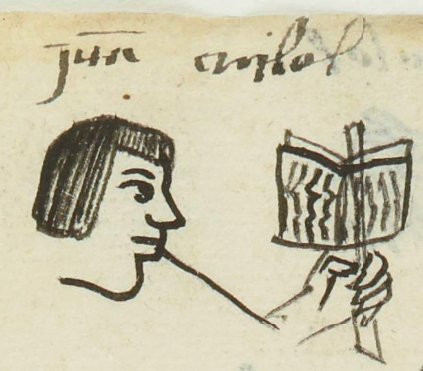Cuilol (MH829r)
This black-line drawing of the simplex glyph for the personal name and occupation Cuilol (literally, a "A Painting," but could be "A Piece of Writing"), here attested as a man's name. The glyph shows a bound book with what appears to be alphabetic writing on it, showing European influence. A (left) hand with a vertical writing implement appears either in front or behind the book. Given this agency, perhaps the translation would be better as "Writer," but writer is tlacuilo, and this is glossed as though a personal name, not put in the place where we find occupation glyphs.
Stephanie Wood
Marc Thouvenot suggested the tracking of words that contain "cuil" as a fruitful line of inquiry. A great many of these glyphs have to do with writing and painting. The term tlacuilo is very well known and so very important for understanding Indigenous writing and painting traditions. Writing and painting overlapped in pre-contact times and into the Spanish colonial era, too. But gradually, Nahuas' thinking about writing began to diverge from painting as they increasingly wrote using the Roman alphabet.
Thouvenot identifies the verb icuiloa (or ihcuiloa, with the glottal stop), which means to paint, write, or print, as having a root of -cuil-. He notes how it also appears in tlacuiloliztli (writing), tlacuilo (writer), and cuicuiltic (mottled). He goes on to show various uses of icuiloa that take it beyond the simple definitions just given, resulting in something like the action of creating a design (e.g., on leather, ceramics, sculpture, or in textiles). It can also be something like the action of decorating (e.g., to put a flower on a cup of atole). He associates icuiloa and tlacuilolli with "cultural artifacts," such as arts and crafts or examples of writing and painting, but cuicuiltic with effects created by "nature." This short summary barely does his article justice; it is worth reading the entire piece. How Thouvenot's study might connect with the concept of bent or curved mentioned by Prem (1974: 555, 682) raises an interesting question. Perhaps the bent or curved lines of writing, painting, carving, embroidery, and so on, fall with in the realm of expressions of -cuil-. See
Marc Thouvenot, "Imágenes y escritura entre los nahuas del inicio del XVI," Estudios de Cultural Náhuatl 41 (2010).
Stephanie Wood
juā cuilol
Juan Cuilol
Stephanie Wood
1560
Jeff Haskett-Wood
nombres de hombres, escritor, pintor, libros, escrituras, cuadros, pintar, escribir

Cuilol, a name, https://nahuatl.wired-humanities.org/content/Cuilol
cuilol(li), a painting or a manuscript, https://nahuatl.wired-humanities.org/content/cuilolli
Escritura (?)
Stephanie Wood
Matrícula de Huexotzinco, folio 829r, World Digital Library, https://www.loc.gov/resource/gdcwdl.wdl_15282/?sp=732&st=image
This manuscript is hosted by the Library of Congress and the World Digital Library; used here with the Creative Commons, “Attribution-NonCommercial-ShareAlike 3.0 License” (CC-BY-NC-SAq 3.0).






